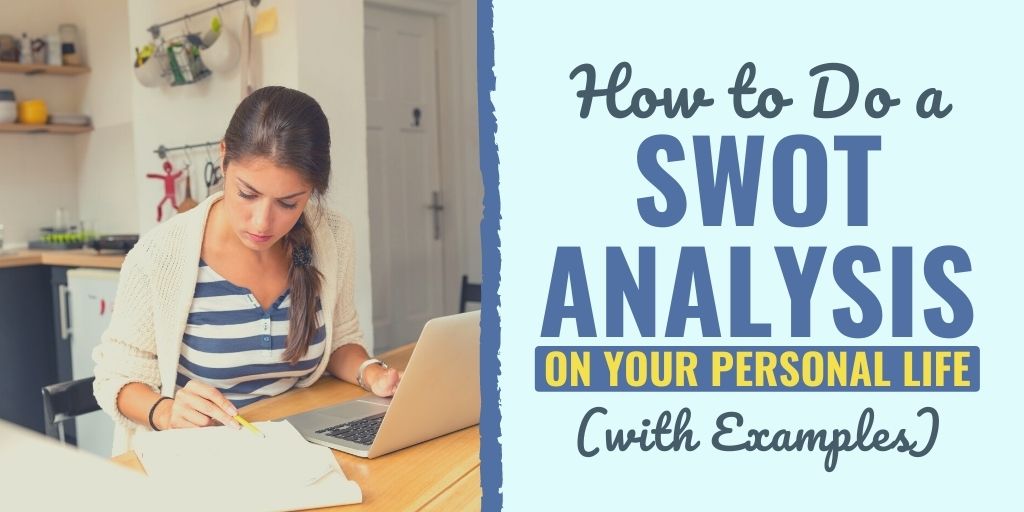There might be affiliate links on this page, which means we get a small commission of anything you buy. As an Amazon Associate we earn from qualifying purchases. Please do your own research before making any online purchase.
A big part of working on personal development is having a clear picture of where you are right now. Knowing exactly where you are versus where you want to be can help you strategically plan for success.
But how can you do an objective self-analysis to determine what makes you unique?
If you do some self-reflection using the SWOT framework, you can begin to see how you’re different from your colleagues and/or peers so you can cultivate the personal talents you have to help you move forward in your career and achieve your goals.
I found it to be very enlightening when I did a personal SWOT analysis as I was applying for jobs after graduating from college. Doing this exercise allowed me to uncover opportunities that I wouldn’t have recognized otherwise and take an objective look at my weaknesses so I could address them directly.
One of the great things about the SWOT analysis framework is how flexible it is. You can use it in a variety of circumstances in your life to help you focus on any goal or problem that you need to address.
In this article, I will explain what a SWOT analysis is and how you can use it in your personal life to accelerate your personal development. Then I will give you an action plan for implementing this idea.
What is a SWOT Analysis?
The SWOT analysis originated in the 1960s to help businesses uncover critical information about what’s going well and what’s not going so well in their organization so they could create a strategic plan for success moving forward. Moving forward, in 1982, the SWOT analysis matrix was formulated to help users have a visual tool for easy comparison. This 2×2 matrix is still used today, with strengths and weaknesses listed on the top row and opportunities and threats listed on the bottom.
The strengths and opportunities in the first column are for factors that you believe are in your favor and in your control. The weaknesses and threats in the second column may be factors that are potentially harmful to you or obstacles for growth, and are externally controlled. Businesses use this tool to look at the relationship between their strengths and weaknesses, find ways to capitalize on their strengths to take advantage of opportunities, and figure out how to progress in their areas of weakness in order to reduce potential threats.
The SWOT analysis is a tried and true business tool that has withstood the test of time, and it can also be helpful for your personal life. The simple structure of the analysis will give you guidance through the complicated process of doing a self-analysis. It will help you learn more about yourself when you’re on the journey to personal development. Not only can doing a SWOT analysis help you find direction in your career, it can also help you find your way in your personal life.
The Benefits of Doing a SWOT Analysis in Your Personal Life
So what types of situations would you find yourself in that could necessitate doing a SWOT analysis? It can really help you in any area of your life where you want to improve, are facing some obstacles, or want to capitalize on the personal strengths that you know you have.
For example, if you can relate to being active in the job market, you’re probably looking for ways that you can set yourself apart from other applicants. In this case, doing a SWOT analysis would benefit you in three ways. First, it would help you do some self-reflection to identify your strong suits. Second, it may help you reframe your job search to positions that you find will be a closer fit with your strengths and abilities. Finally, your SWOT analysis will offer you a visual representation of who you are, which will make it much easier to answer the dreaded question in interviews, “What are your strengths and weaknesses?”
You can also use a SWOT analysis if you’re in the dating world. If you’re looking for a partner, do some self-reflection on who you are as a partner. Consider your strengths when it comes to dating, what are you good at doing? Maybe you’re great at meeting someone else’s friends and family or you can make any awkward first date more comfortable. What about your weaknesses? Do you lack self-confidence? Are you scared of commitment?
Next, look at your opportunities. What avenues could help you meet a partner that you haven’t explored yet? Have you done some online dating? Or maybe you could reconnect with an old flame? Finally, consider your threats. What could possibly block your success? Do you have a clingy ex who can’t let go or maybe your work schedule doesn’t allow you the time that you need to be in a relationship.
By doing this SWOT analysis for dating, you will then be able to pinpoint and use your strengths to your advantage, work on your weaknesses, explore new opportunities, and try to mitigate some threats.
How to Implement a SWOT Analysis in Your Personal Life
In order to make it worth your time to complete a personal SWOT analysis, you will need to dedicate enough time to really reflect on your life, characteristics, abilities, and experiences. You probably won’t complete your SWOT analysis in one try, rather it will be a living document that may change over time. That said, let’s look at the process of creating your SWOT analysis.
The first thing you have to do is identify your goal or problem. Be specific about what you want to happen and make it clear when you will know that you have been successful. After you have your main topic in mind, you can go into the analysis portion of the process.
Here are some questions to ask yourself after drawing your 2×2 SWOT analysis matrix, starting with your internal factors (strengths and weaknesses).
Internal Factors
When you’re reflecting on your strengths and weaknesses, you are analyzing internal factors such as your personal characteristics, knowledge, financial situation, skills, abilities, personal network, etc. These are the factors that you can influence, and you should be proactive in these areas.
You should know your strengths and use them to your advantage. You should also continue to foster and develop your strengths so they continue to be a strong point. You should also know your weaknesses and have a plan regarding how to improve upon them.
Strengths
You may be able to rattle your strengths off without putting too much thought into it, but if you take the time to consider some specific questions, it will help you come up with some strengths that may be especially unique to you or some that you haven’t yet considered or didn’t recognize as being strengths. Write down everything that you come up with, even if it seems irrelevant to your goal. Do this for each quadrant of the SWOT analysis. Think about the following questions:

Weaknesses
External Factors
Your threats and opportunities are external factors, which are out of your control. This includes things like market trends, economic stability, technological advances, and political changes. When looking at your opportunities and threats, you’re analyzing any type of environmental factor that could affect you. Because these factors are largely out of your control, you need to be as flexible as you can.
Opportunities
Threats
Remember to be objective when thinking about these questions. You may need to consult other people to ensure you’re not simply reciting back your own beliefs. It is important to be completely honest when you’re creating your SWOT analysis by honoring your strengths and not hesitating when you list your weaknesses.
Personal SWOT Analysis Sample
Let’s look at what this could look like in action. Here is an example of what a SWOT analysis could look like for someone who is job hunting:
Strengths
Weaknesses

Opportunities
Threats
Of course your own SWOT analysis will not look exactly like this, but you’re able to get an idea of the types of things you can put down in the quadrants.
Once you have your own SWOT analysis completed, you can evaluate your results through either matching or converting. When you match, you can connect categories to formulate an action plan. For example, you can match your strengths to your opportunities to see where you can be proactive. So in the example above, you could say that because you’re very organized, you can try to find a way to incorporate an online class or two into your schedule.
You can also match your weaknesses to your threats to find areas of your life that you should be cautious of or pay more attention to. For example, if you’re indecisive, but also trying to move to a new city in the near future, time may be an important element in your planning because you probably want to start working sooner rather than later.
You can also evaluate your SWOT results by converting your negatives into positives. For example, the market is saturated with other people fighting for the same positions that you are, but you’re impatient, which means you can be assertive and proactive in pursuing the job openings that you come across.

The purpose of doing a personal SWOT analysis is to pinpoint actions you can take to meet the requirements of achieving your long-term goals. In the example of looking for a job, comparing your strengths and weaknesses to the requirements of the jobs you’re applying for can help you recognize gaps so you can prepare yourself to be the best candidate for the job. Once you put your analysis into action, track your progress so you can see yourself moving closer to achieving your ultimate goal.
If you don’t take the time to evaluate your SWOT analysis by identifying the elements that can be leveraged to help you succeed, it won’t be effective. You have to find ways that your strengths could be beneficial to you on your road to achieving your goal or figure out how you can work around potential threats so they don’t impede your progress.
Final Thoughts on Your Personal SWOT Analysis
Doing a SWOT analysis on your personal life is an effective way to leverage your strengths to your advantage, improve upon your weaknesses, take advantage of any available opportunities, and find ways to plan ahead to mitigate potential threats.
When you’re thinking about each of the quadrants of the SWOT analysis, make an effort to be as honest and comprehensive as possible. You may realize that a strength you possess is more useful for your current goal than you once thought it was.
Personal development can be a tough process, especially if you notice some things in you life that you need to let go of in order to better yourself. However, by using the SWOT analysis, you can hopefully identify avenues that can help lead you to success. You can use this process for every goal in your life, but it might be more useful to only take it out when you are facing a problem that is especially challenging. Because the SWOT analysis will help you reorder your thinking, it can help you see problems in different ways.

Connie Stemmle is a professional editor, freelance writer and ghostwriter. She holds a BS in Marketing and a Master’s Degree in Social Work. When she is not writing, Connie is either spending time with her 4-year-old daughter, running, or making efforts in her community to promote social justice.
Finally, if you want to level up your productivity and time management skills, then watch this free video about the 9 productivity habits you can build at work.


